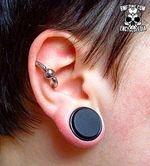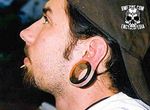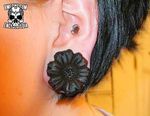Ebony
Ebony is a kind of hardwood commonly used in wooden body jewelry for ear stretching (and other purposes). "Ebony" refers to African and Asian trees of the Diospyros genus which have a black or very dark brown wood (which may sometimes have lighter streaks). Because ebony is incredibly hard, it has many uses and has become one of the most expensive kinds of wood as it becomes continuously endangered. For example; in Kenya, where 50,000 ebony trees are cut down annually, only small pockets of ebony remain. Because of this destruction, Kenya has tried to regulate the international ebony trade, but resistance from Tanzania, Mozambique and other nations has made progress difficult.
It is very rare for ebony to come from a renewable source. While a small number of jewelers working with ebony go to efforts to make sure they are buying from a renewable source (either ebony farms or by breaking down old furniture), very few do. If you purchase ebony jewelry, you may be supporting deforestation.
L-R: Simple ebony plug, ebony tunnel, carved jewelry
Ebony allergies are possible, but not common — ebony dust reactions for those lathing it are much more common. Ebony jewelry should have an excellent lifespan, assuming you take care of it. It shouldn't need more than an occasional oiling to keep it from drying. If the jewelry dries up, it can crack and is far more likely to shatter if you drop or mistreat it.



